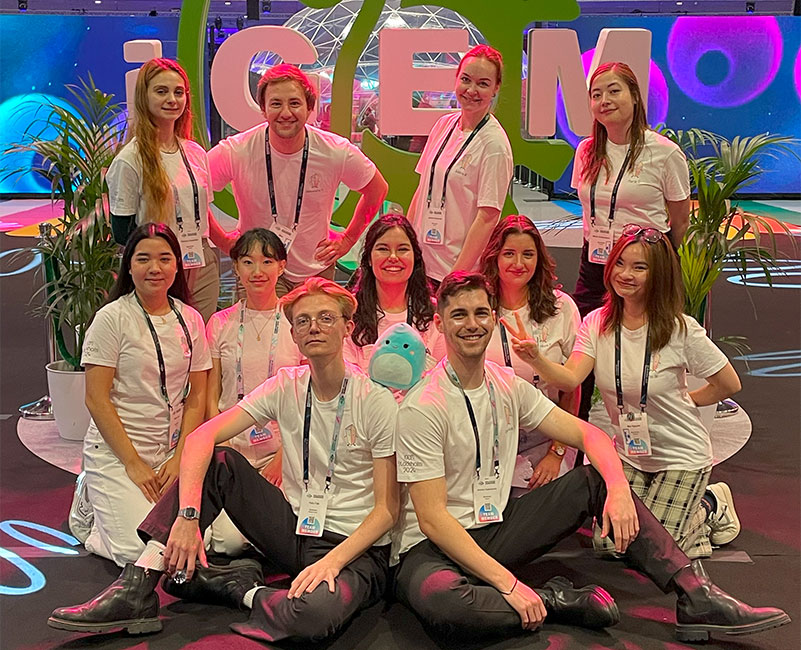Shimmer is a central cosmetic ingredient to create sparkle, and is often unethically sourced. The team representing Stockholm in iGEM 2024 take steps to make shimmer more sustainable using synthetic biology.
The International Genetically Engineered Machine (iGEM) Foundation started in 2003 at Massachusetts Institute of Technology (MIT), is dedicated to the advancement of synthetic biology. Uniting students, researchers and innovators worldwide, participants create innovative projects and present them at the annual Jamboree in Paris. iGEM promotes community-building, education and entrepreneurship through initiatives like iGEM Startups and Technology, shaping the future of synthetic biology with collaboration and innovation.
Sustainable makeup shimmer
This year, a team of 13 students from KTH Royal Institute of Technology, Karolinska Institutet (KI) and Stockholm University (SU) represented Stockholm in the competition. The project focused on creating more sustainable cosmetics using synthetic biology.
– Our project tried to address the problem of unsustainable and unethical shimmer products in current cosmetic products, since most shimmer comes from mineral mining which poses large scale environmental harm and also unethical labour practices such as using child labour, explains team member Edna Lam from the media team.
Besides the mineral mica, shimmer is also created by guanine crystals. These are sourced from fish scales, a process which also has negative ecological impacts. In communication with stakeholders and the general public, the team recognized an increasing demand for ethically sourced and vegan makeup products led the team to seek out a better alternative.
Guanine crystals from E. coli
A 2023 article from Pavan and colleagues in the journal BMC Biology described natural guanine crystal production in certain Aeromonas strains, which the team decided to replicate in the more workable E. Coli bacteria. The proposal, BioGlimmer, employs two genetic engineering approaches. On one hand, the genes guaA and guaB responsible for guanine production are upregulated. On the other hand, the guaD gene responsible for guanine degradation is downregulated using CRISPR. In concert, the aim was that these would lead to an accumulation of guanine and eventual crystal formation.
– By working on BioGlimmer we aimed to develop a more sustainable, cruelty free and environmentally friendly alternative to current glitters, majority of which are not made in a transparent and eco-friendly way. Thus, this project is also a way to promote a shift in the beauty and fashion industry towards more sustainable and green methods, explains Team member Juliana Baranova from the research team.
Cooperation is key
iGEM Stockholm is a multidisciplinary team, bringing together expertise from different fields of life science. The team was organised into sub-groups, each with a specific focus:
Research team - Divided into wet lab and dry lab teams, they designed and conducted the experiments to establish the project’s proof of concept.
Finance and entrepreneurship team - They managed scholarships, secured funding and developed the business model.
Media and communication team - Responsible for creating and maintaining the websites and social network and the creation of presentation videos and materials.
Human practices team - Focused on public engagement and gathering expert insights. They organised an ethics workshop for highschool students at St. Martins Gymnasium and reached out to stakeholders, professors, cosmetic companies and schools to discuss our project impact. To celebrate iGEM Stockholm’s 10th year of participation, the team developed an interactive game to promote synthetic biology, making it accessible and engaging for a wider audience.
Additionally, all team members participated in presenting the project at international conferences and university fairs.

In the team: Diandra Daumiller, Aleksandras Gaudiesius, Juliana Baranova, Maria Gustavsson, Edna Lam, Jiaxin Wu, Carmen de Ancos Jimeno, Teodora Pavlicu, Mai Nguyen, Felix Falk, Dimitrios Tsagkogiannis. In the team but missing in the photo: Meghana Bhat and Hongge Wang.
Spreading awareness about synthetic biology
Just as important to the research is the interaction between the team, the project idea and society at large. The team made several efforts to gather feedback as well as spread awareness about how synthetic biology can contribute to sustainable development. While still in the brainstorming phase, the team held a panel discussion with KI and KTH professors to refine their idea. Several cosmetics companies were also contacted to discuss how the solution could impact the industry.
Furthermore, the team had the opportunity to present the project at several conferences with other iGEM teams in Sweden, Finland, Denmark and Germany.
– Our project was well received at the conferences we attended, especially as people never even realised the problems behind the shimmer in their everyday cosmetic products, they were able to develop an awareness of this and realise the wider impact of our project, explains Edna Lam.
To educate about synthetic biology and sustainable cosmetics, the team visited a cosmetics high school. They also developed two separate games: a card game in collaboration with the other Swedish iGEM teams (Uppsala, Linköping, Gothenburg, Lund) about the iGEM process, and a digital game about the history of iGEM Stockholm projects.
Advantages with participating
Participating in iGEM is a unique experience that helps students develop multidisciplinary skills while providing opportunities to expand their international network.
– I learnt a lot of new skills throughout my iGEM journey, as a media and communications member I learnt a lot about producing animations for video making. Of course, I also learnt a lot about synthetic biology and exploiting microorganisms to produce desired products through overexpression and CRISPRi knockout systems, says Edna Lam.
– I learned a great deal about synthetic biology potential and have seen valid examples of how it is utilized to make the world a better place. Apart from that, I learned a lot about research infrastructure in Sweden, about financing opportunities for research projects, and gained valuable experience in project development, adds Juliana Baranova.
Links:
Text by Teodora Pavlicu and Felix Falk
